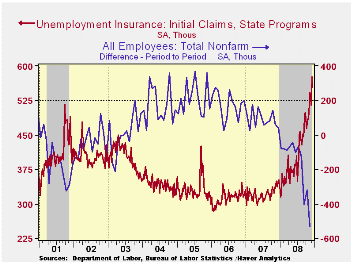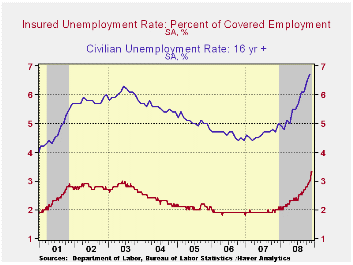 Global| Dec 18 2008
Global| Dec 18 2008U.S. Weekly Claims For Unemployment Insurance Dipped
by:Tom Moeller
|in:Economy in Brief
Summary
Last week, initial claims for unemployment insurance dipped by an expected 21,000. The decline to 554,000, however, reversed only a third of the prior week's 60,000 increase which was revised up slightly. As a result claims remained [...]

Last week, initial claims for unemployment insurance dipped by an expected 21,000. The decline to 554,000, however, reversed only a third of the prior week's 60,000 increase which was revised up slightly. As a result claims remained up by 85% from their lows of last year.Expectations had been for claims last week of 555,000 and the four-week moving average of initial claims rose again to this cycle's high of 543,750 (58.2% y/y).
The latest figure covers the survey week for December nonfarm payrolls and there was an 11,000 (2.0%) increase from the November period. Over the last ten years there has been an 81% inverse correlation between the level of initial claims and the month-to-month change in employment.
The Labor Department indicated that the largest increases in initial claims for the week ending December 6 were in North Carolina (+26,596), California (+22,963), Georgia (+20,237), Pennsylvania (+20,090), and Tennessee (+12,170), while the largest decreases were in Wisconsin (-8,593), Iowa (-3,424), North Dakota (-895), Arkansas (-514), and Idaho (-320)
Continuing claims for unemployment insurance during the week of December 6 fell 47,000 after an upwardly revised (slightly) 340,000 during the prior week. The latest was the highest level since 1982. The four-week average of continuing claims rose to 4,226,000. Continuing claims provide some indication of workers' ability to find employment and they lag the initial claims figures by one week.
The insured rate of unemployment was stable w/w at this cycle's high of 3.3%. The highest insured unemployment rates in the week ending November 29 were in Oregon (5.6 percent), Alaska (5.3), Puerto Rico (5.2), Michigan (5.0), Wisconsin (4.8), Idaho (4.7), South Carolina (4.6), California (4.5), Nevada (4.5), Arkansas (4.4), and Pennsylvania (4.4).
Financial Crisis Casts Shadow Over Commercial Real Estate from the Federal Reserve Bank of Dallas can be found here.
| Unemployment Insurance (000s) | 12/13/08 | 12/06/08 | 11/29/08 | Y/Y | 2007 | 2006 | 2005 |
|---|---|---|---|---|---|---|---|
| Initial Claims | 554 | 575 | 515 | 58.7% | 322 | 313 | 331 |
| Continuing Claims | -- | 4,384 | 4,431 | 65.6% | 2,552 | 2,459 | 2,662 |
Tom Moeller
AuthorMore in Author Profile »Prior to joining Haver Analytics in 2000, Mr. Moeller worked as the Economist at Chancellor Capital Management from 1985 to 1999. There, he developed comprehensive economic forecasts and interpreted economic data for equity and fixed income portfolio managers. Also at Chancellor, Mr. Moeller worked as an equity analyst and was responsible for researching and rating companies in the economically sensitive automobile and housing industries for investment in Chancellor’s equity portfolio. Prior to joining Chancellor, Mr. Moeller was an Economist at Citibank from 1979 to 1984. He also analyzed pricing behavior in the metals industry for the Council on Wage and Price Stability in Washington, D.C. In 1999, Mr. Moeller received the award for most accurate forecast from the Forecasters' Club of New York. From 1990 to 1992 he was President of the New York Association for Business Economists. Mr. Moeller earned an M.B.A. in Finance from Fordham University, where he graduated in 1987. He holds a Bachelor of Arts in Economics from George Washington University.






